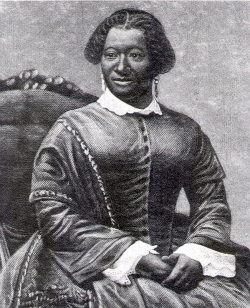Elizabeth Greenfield facts for kids
Elizabeth Taylor Greenfield (born around 1809 – died March 31, 1876) was an amazing American singer. People called her "The Black Swan" because her voice was so beautiful. She was one of the most famous Black concert artists of her time. A writer named James M. Trotter said she had "remarkably sweet tones and wide vocal compass," meaning she could sing many different notes very well.
Contents
Life Story of Elizabeth Greenfield
Early Life and Freedom
Elizabeth Greenfield was born into slavery in Natchez, Mississippi. This happened sometime between 1817 and 1826. Her mother's name was Anna Greenfield.
In the early 1820s, Elizabeth's owner, Elizabeth H. Greenfield, moved to Philadelphia. She decided to free her enslaved people. Elizabeth H. Greenfield worked with a group that helped formerly enslaved people. Many of them, including Elizabeth's mother, moved to Liberia in Africa in 1831. But Elizabeth stayed in Philadelphia.
Learning Music
Elizabeth Greenfield studied music when she was a child. This was special because musical training was not usually given to people in her situation. She was connected with the Quakers, a religious group.
First Concerts
Around 1851, Elizabeth began singing at private parties. Her first public performance was at the Buffalo Musical Association. From 1851 to 1853, she went on tour. Her manager was Colonel J. H. Wood. He was a promoter, like P. T. Barnum. Sadly, he did not allow Black people to attend her concerts.
In 1853, Elizabeth sang at Metropolitan Hall in New York City. This hall could hold 4,000 people, but only white people were allowed to attend. After this concert, Elizabeth apologized to her community for their exclusion. She then gave a special concert to help the Home of Aged Colored Persons and the Colored Orphan Asylum.
Performing for Royalty
In April 1853, Elizabeth traveled to London, England. She was supported by important people like the Duchess of Sutherland and Harriet Beecher Stowe. In London, she learned from George Thomas Smart, who was the organist for Queen Victoria's royal chapel.
On May 10, 1854, Elizabeth performed for Queen Victoria at Buckingham Palace. She was the first African American artist to sing for British royalty. Harriet Beecher Stowe wrote about this special event. Elizabeth also received support from other duchesses in England.
Musical Style and Later Career
Elizabeth Greenfield was famous for singing music by well-known composers. These included George Frideric Handel, Wolfgang Amadeus Mozart, and Gioachino Rossini. She also sang popular American songs like "Home! Sweet Home!" and "Old Folks at Home".
After returning to the United States, she continued to tour. She also opened a music studio in Philadelphia. One of her students was Thomas Bowers, who became a famous singer himself. In the 1860s, Elizabeth created and directed an opera group with Thomas Bowers.
Elizabeth Greenfield passed away in Philadelphia on March 31, 1876. She was a member of the Philadelphia Shiloh Baptist Church.


